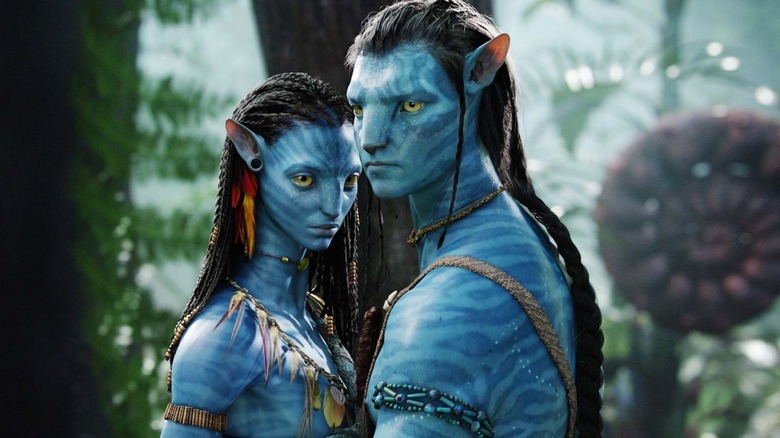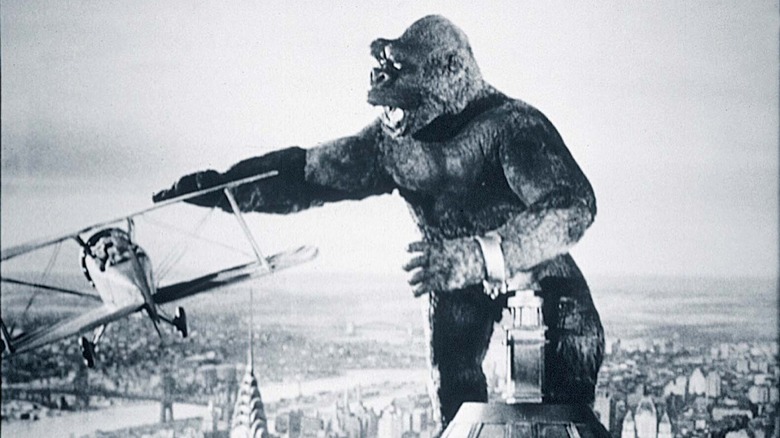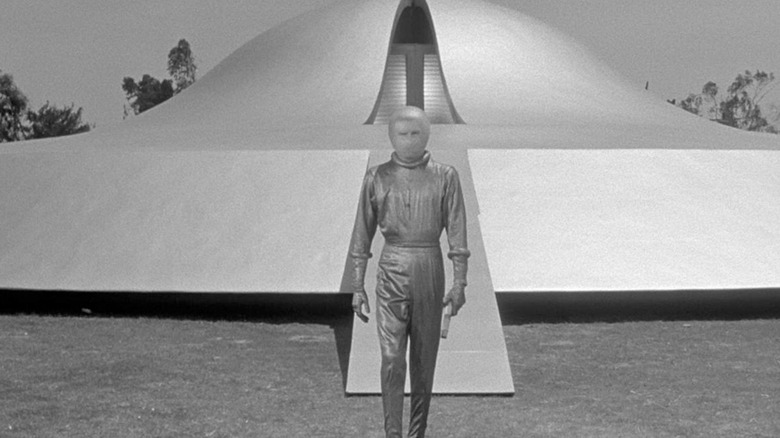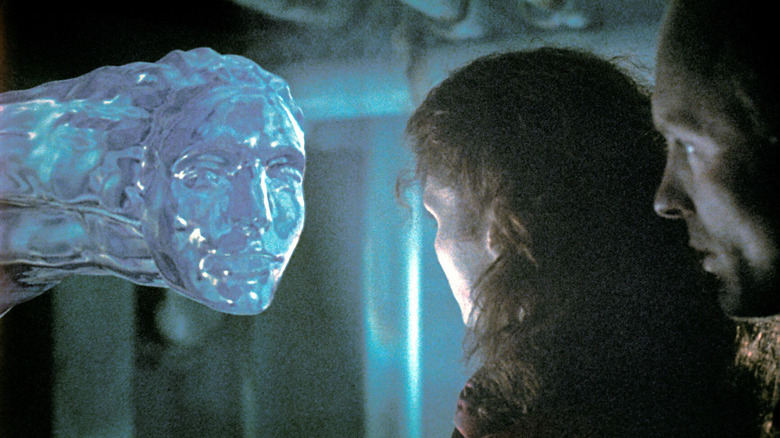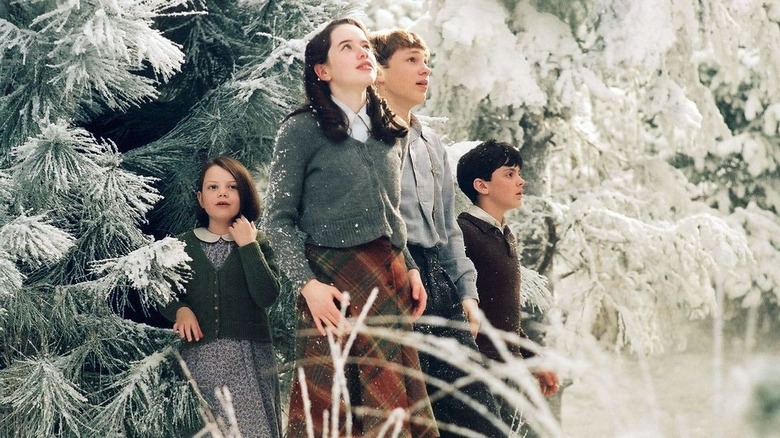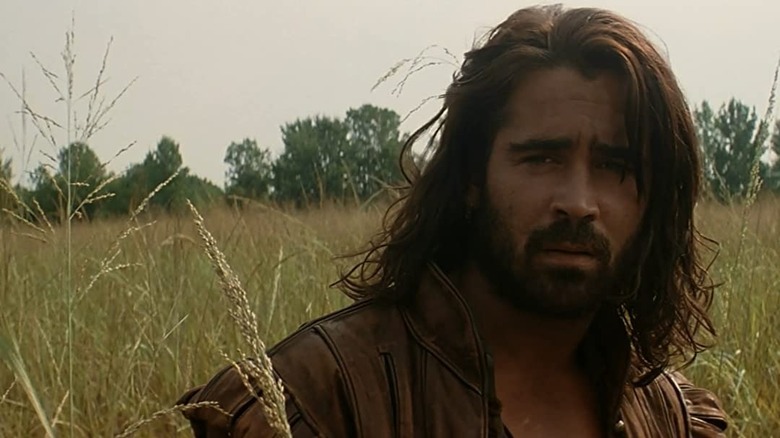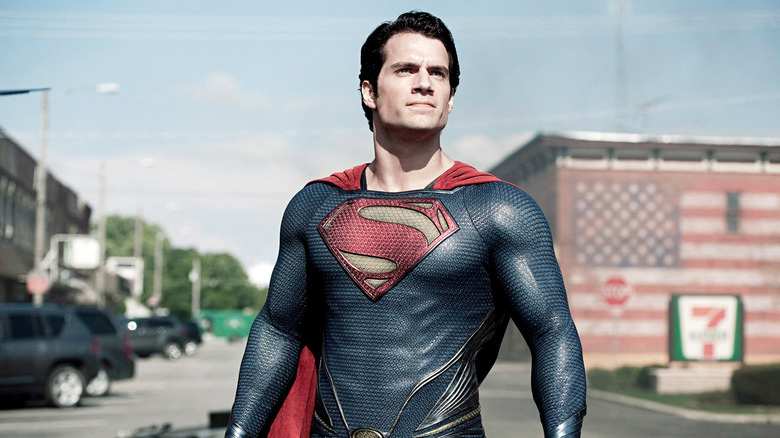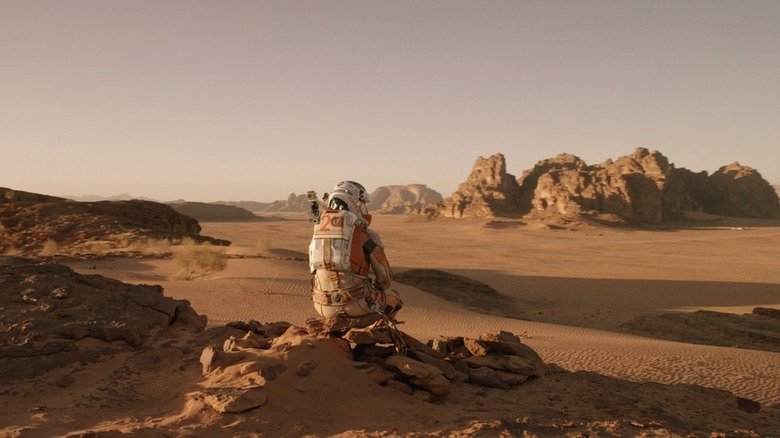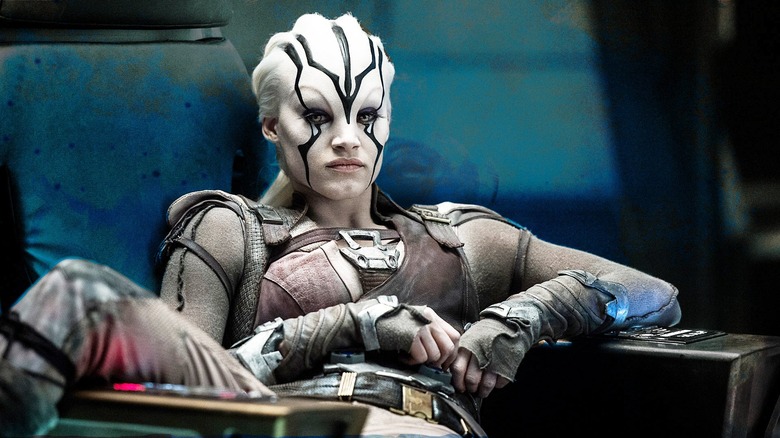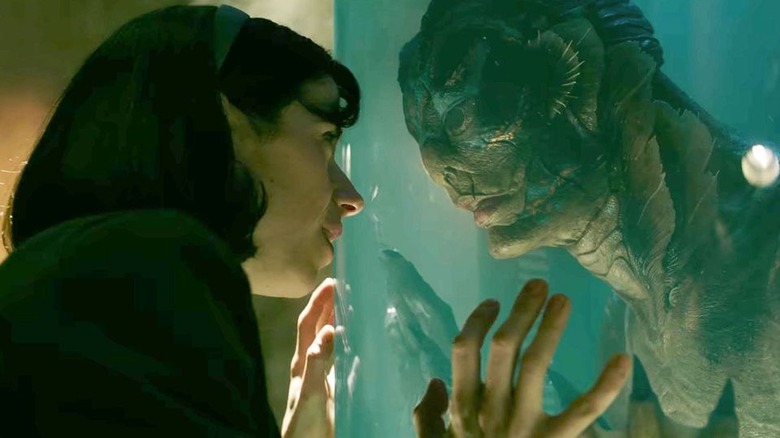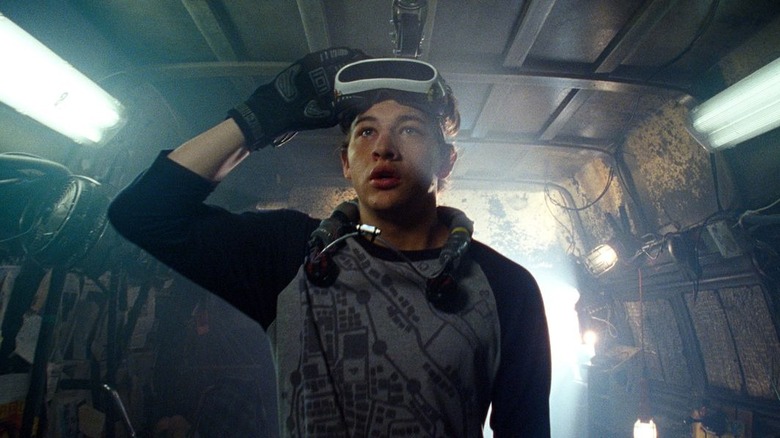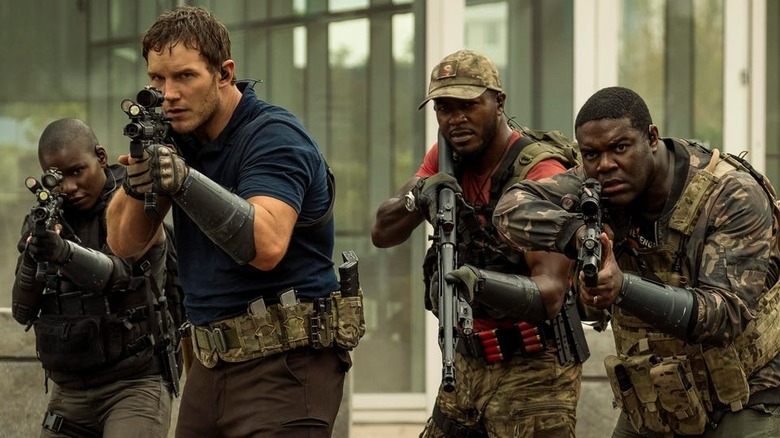Movies Like Avatar That Are Just As Visually Stunning
At the time, "Avatar" was a box office phenomenon the likes of which the film industry had never seen. It shouldn't have surprised anyone: Director James Cameron had proven himself a titan of that particular arena back in the '90s, unleashing one groundbreaking, blockbuster event film after another, and he'd worked for over a decade developing this ambitious sci-fi project — an epic that wasn't based on any previously existing material.
The road to production wasn't easy, as Cameron's latest forced him to develop immersive 3D technology and visuals that were unprecedented on film. With a massive budget and heavy marketing campaign, "Avatar" could've been the disaster that effectively shut Cameron out of filmmaking forever. It certainly wasn't! "Avatar" wowed audiences and crushed its opening weekend, and would be among each week's top-grossing films for months. Not only did it become the highest-grossing film ever, but the first to top the $2 billion mark. "Avatar" was briefly outgrossed by "Avengers: Endgame," but it regained its status as the biggest movie ever thanks to a re-release in March of this year.
Cameron stated from the beginning that "Avatar" was intended to be the first in an ambitious franchise. "Avatar 2" is scheduled to hit theaters on December 16, 2022, and "Avatar 3" is set for December 20, 2024.
If you loved "Avatar," these visually stunning movies are also worth watching.
King Kong
The technology that Cameron used to create the groundbreaking visual effects of "Avatar" was the culmination of a rich cinematic history of innovation. Fully computer-generated characters weren't introduced until the appearance of Jar Jar Binks in "Star Wars: Episode I – The Phantom Menace," and the full extent of CGI capabilities weren't evident until Steven Spielberg unveiled his dinosaurs with "Jurassic Park." The original 1977 "Star Wars" was a game-changer thanks to the work of Industrial Lights and Magic, but George Lucas's technical breakthroughs were only possible thanks to the stop motion animation developed by Ray Harryhausen on films like 1963's "Jason and the Argonauts" and the outer space visuals in Stanley Kubrick's "2001: A Space Odyssey."
Looking back even further, early sci-fi and fantasy films from the classic eras of cinema were integral to the advancements we see today. One of the earliest examples of visual storytelling was the original 1933 "King Kong," which featured miniatures, rear projection screens, matte paintings, and stop motion unlike anything viewers had seen. "King Kong" created one of the most iconic screen monsters in history, and the film inspired generations of visual artists. Some classic films are better appreciated for their importance than their entertainment value, but the original "King Kong" is an endearing masterpiece that boasts the same sense of excitement and emotional devastation today as it did in the pre-Code era. It's remarkable that after many reimaginings and sequels, "King Kong" is still the best in the series.
The Day The Earth Stood Still
Following "King Kong," one of the most influential films for visual effects was 1951's science fiction adventure film "The Day The Earth Stood Still." Sci-fi films featuring Martian visitors and flying saucers were incredibly popular in the 1950s, with "War of the Worlds," "Forbidden Planet," "The Thing From Another World," "It Came From Outer Space," and "Them!" all hitting theaters. However, "The Day The Earth Stood Still" was particularly effective in how it used impressive visuals to tell an emotional and politically relevant story ... much as "Avatar" would nearly 60 years later.
Released amidst the Cold War when the "Red Scare" had swept the nation and the nuclear arms race was raging, "The Day The Earth Stood Still" had a universal message of peace and unity. Like "Avatar," it showed that humans and aliens should not be enemies, and that mankind's aptitude for violence and expansion only triggers conflict. Having sympathy for an intergalactic visitor marked a sharp contrast with many other sci-fi efforts of the era.
The film follows the aftermath of a flying saucer's visit to the White House. A strange alien known as "Klaatu" addresses the President of the United States stating he comes "in peace and good will," but immediately he's shot by the U.S. military. Klaatu's protector, the giant robot Gort, attempts to protect him, but he insists on a peaceful solution.
The Abyss
Cameron's own innovations in VFX were integral to what he achieved with "Avatar," as throughout his career he showed groundbreaking dexterity with whatever budget he was granted. 1984's "The Terminator" was produced on a smaller scale that Cameron utilized to perfection, and when he was given the opportunity to helm 1986's "Aliens," he created a thrilling visual achievement worthy of Ridley Scott's already highly influential work on the original 1979 "Alien." Compared to the rest of his filmography, 1989's "The Abyss" is hardly Cameron's most entertaining movie, but the film's CGI sequences laid the groundwork not only for Cameron, but for the entire industry.
"The Abyss" centers on a ground of underwater explorers that respond to a distress call from a sinking American vessel within the depths of the Caribbean. When Soviet Union ships begin to circle the doomed vessel, scientists Bud Brigman (Ed Harris), Dr. Lindsey Brigman (Mary Elizabeth Mastrantonio), and US Navy SEAL Lieutenant Hiram Coffey (Michael Biehn) work with their respective teams in a race against time. They discover that the reason for the submarine's disappearance isn't tied to a political conflict, but rather an extraterrestrial threat.
To create the synthetic, liquid creatures, Cameron considered the possibility of stop motion before ultimately deciding to utilize early CGI. The moment where the "pseudopod" embodies Bud and Lindseys' faces was shot on a separate screen and digitally recreated, something never done before. Two years later, Cameron pulled off another visual feat with the T-1000 in "T2."
Big Fish
It takes a great filmmaker to utilize visual effects without becoming lost in the spectacle. True visual auteurs are able to craft a distinguishable style that is distinct both with or without special effects, and use CGI elements in tandem with practical work, great characters, compelling dialogue, and exciting stories. Cameron is certainly an artist who can't be replicated; it's notable when looking at other CGI-driven films and seeing the lack of care put into the visual artistry. Cameron's films are exciting, action-packed, and even absurd, but they tell great stories and feature memorable characters. These are all characteristics that he shares with another great auteur, Tim Burton.
Burton and Cameron may not seem inherently similar, but both tend to tell stories focused on outsiders separated from normal society. Cameron enjoys highlighting rebels and outcasts who heroically fight against the system, and Burton enjoys humanizing the idiosyncratic, strange weirdos who are forcibly cast out. You couldn't possibly mistake Burton's films for anyone else's, and at his best, his work is very affectionate and sincere. At their heart, both directors are romantic; "Avatar" is a love story of two outsiders, one human and one Na'vi, who unite despite the pressures of their respective cultures.
Romance is integral to Burton's work, and his 2003 fantasy drama "Big Fish" is openly heartwarming. The film centers on the sincere Will Bloom (Billy Crudup) as he struggles to connect with his dying father (Albert Finney), and through flashbacks learns of his romances and adventures.
The Chronicles of Narnia: The Lion, The Witch, and the Wardrobe
One of the best aspects of "Avatar" is the film's sense of wonder, which is highlighted through the character of Jake Sully (Sam Worthington). "Avatar's" immersive world of Pandora was crafted with Cameron's groundbreaking CGI, and detailed the lush environments of the planet with immaculate detail. Part of the film's appeal was the imaginative spirit, and it kept viewers coming back for multiple viewings. What makes "Avatar" a great movie and not just an IMAX showcase is the fact that the viewers are sharing this experience with someone. Jake is in a particularly sensitive situation, as he's bound to a wheelchair after sustaining a wartime injury. Jake never thought he would be able to walk again, much less go on an adventure, and his newfound abilities as a result of his Na'vi body give him that chance. It's an emotional experience for him.
That same sense of vulnerability is felt by the five Pevensie children as they venture to a far away magical land in the first in the trilogy of C.S. Lewis adaptations, "The Chronicles of Narnia: The Lion, The Witch, and The Wardrobe." Peter (William Moseley), Susan (Anna Popplewell), Edmund (Skandar Keynes), and Lucy (Georgie Henley) are evacuated from their normal home in London amidst the Nazi bombings of World War II, and fear they'll never find comfort again. The land of Narnia is dangerous, but promises them a new home and mentor in Aslan (Liam Neeson).
The New World
"Avatar" is a very politically charged film. It's not hard to make comparisons between mankind's brutal treatment of the Na'vi natives of Pandora and the treatment of indigenous people throughout the bloody history of the United States. Cameron isn't aiming for subtlety, but he is certainly effective in generating empathy for the Na'vi by showing their society and culture in rich detail. Jake Sully is an outsider in this environment and learns to adjust to the new culture, and is respectful of their traditions. It may have been an enlightening experience for viewers that challenges their conception of what "metaphorical science fiction" can be.
Films that explore these sensitive issues of representation, assimilation, genocide, and cultural warfare walk a difficult line. On one hand, a film must remain true to history and tell the story from the right perspective, but it also must be a compelling story in its own right. No one film can be representative of generations of massacres, and it's best to tell a personal story that is specific to just one aspect. Terrence Malick pulled off these challenges with his gorgeous, haunting look at the founding of Jamestown in 1605 with his 2005 romantic epic "The New World."
"The New World" follows Captain John Smith (Colin Farrel) as he travels to the early Virginia settlement and encounters Pocahontas (Q'orianka Kilcher). Both Smith and James Rolfe (Christian Bale) grow to love Pocahontas and seek her hand. Malick delicately shows these sensitive romances.
Man of Steel
"Man of Steel" is far from a perfect film. Zack Snyder's take on the origins of Clark Kent/Kal-el (Henry Cavill) is riddled with inconsistencies, uncomfortable tonal shifts, an awkward structure, and a fundamental misunderstanding of how Superman embodies "hope." However, as a work of visual storytelling, "Man of Steel" is simply breathtaking, capturing both the exotic alien locations and the reality of modern metroplexes. It's a work of realism, style, and imagination that is rarely matched in modern comic book films; if many superhero films look as if they were shot in static backgrounds and stock locations, Snyder's epicness rivals what Cameron did with "Avatar."
The film opens with a jaw-dropping opening sequence that explores the final days of the alien planet Krypton before its destruction, an event only hinted at in the original 1978 classic, "Superman: The Movie." Like Cameron, Snyder dedicates time to exploring a functioning society with distinguishable political infrastructure and cultural landmarks. Krypton's politics are in flux, as the evil General Zod (Michael Shannon) rebels against the council. Jor-el (Russell Crowe) looks to find a solution to the conflict, but he's also trying to find a home for his son.
Once Kal-el ventures to Earth, Snyder shows the beauty of the natural world as he discovers his abilities. Removed from the convoluted narrative, the sequence of Kal-el flying for the first time is filled with the same breathtaking sense of discovery that Jake feels in "Avatar."
The Martian
"Avatar" is obviously a work of science fiction, but it's also a very pro-science movie. Cameron has always worked with the idea that sci-fi is more effective if the internal logic of the movie makes sense, and even when depicting otherworldly creatures like the Xenomorphs or Terminators, there's a grounded tone where the characters are taking the processes seriously. It's especially true in "Avatar," as there is meticulous time paid to showing the tech that allows Jake to embody his Na'vi avatar, and in the work he does with the biologist Dr. Grace Augustine (Sigourney Weaver).
A respect for the scientific process is something that Cameron shares with fellow "Alien" franchise director Ridley Scott. Scott is one of the most influential science fiction directors in cinematic history, and his 2015 film "The Martian" is a tribute to the scientists and explorers that make groundbreaking achievements possible. The film is so meticulous in detailing what an actual Martian voyage would look like, yet still tells an exciting adventure story with real emotional stakes.
Adapted from the bestselling novel by Peter Weir, "The Martian" centers on a team of astronauts stationed on Mars in 2035. The mission's leader, Commander Melissa Lewis (Jessica Chastain), decides to evacuate the team amidst a devastating storm, but in the frantic weather, botanist Mark Watney (Matt Damon) is lost and presumed dead. It's only after the ship has left the planet's surface that they discover that Watney is still alive.
Star Trek Beyond
"Avatar" does a great job capturing conflicts that are both exploratory and villainous in nature. Many of the early scenes are dedicated to Jake simply exploring the world of Pandora and experiencing its natural wonders and dangers. His situation grows more complicated once he becomes aware of the military plot by Colonel Miles Quaritch (Stephen Lang) to stage a mining operation that will dissipate the planet and slaughter the Na'vi. It's a blatantly political work of science fiction with anti-militarism and anti-corporate themes, yet feels optimistic in its message of coexistence.
These same themes are ones "Avatar" shares with the "Star Trek" franchise. The original "Star Trek" series from Gene Roddenberry was groundbreaking in the 1960s for its blunt political statements, and the threats that Captain Kirk, Spock, and the crew of the "U.S.S. Enterprise" faced every week were both tied to their mission of exploration and unjust government practices that threatened their goal of a positive future. While the six "Star Trek" films starring the returning original cast explored various themes brought up within the series, the film in the franchise that best represents Roddenberry's original intentions is a chapter in the reboot saga.
2016's "Star Trek Beyond" is actually structured in a very similar fashion to "Avatar." After the "U.S.S. Enterprise" crash lands on the planet Altamid, they must face off against the planet's native monsters before unraveling a political conspiracy tied to former Starfleet Captain Balthazar Edison (Idris Elba).
The Shape of Water
"Avatar" is a love story about two people of different species who come together amidst a violent political conflict and environment. Jake grows attracted to Neytiri (Zoe Saldana), and they bond as they adventure together and he eventually reveals that he is a human. Neytiri's Omaticaya clan disapproves of the romance, and Jake's military advisors can't believe he would actually fall in love with a native. However, Jake and Neytiris' romance helps lead a revolution against a mining operation that would be disastrous for both species.
This exotic love story with heavy political connotations is reminiscent of Guillermo del Toro's 2017 best picture winner, "The Shape of Water." During the height of the Cold War, mute janitor Elisa Esposito (Sally Hawkins) works in a secret U.S. Government research lab and discovers a strange amphibious alien creature (Doug Jones) who she's able to communicate with using sign language. Elisa learns to love this amphibian man, and their moments of intimacy are deftly captured by del Toro.
Ready Player One
The notion of exploring a body that is not your own is a unique aspect of "Avatar," one which serves to make the story more exciting. Jake is unhappy with his life prior to joining the research mission to Pandora, as he feels limited by his disabilities to do the type of dangerous missions that he seeks. Although embracing the Na'vi avatar that he's embodied with is initially an awkward transition, he grows to feel more at home in his new body than he ever did before.
Learning to embrace an avatar body is a key point in Steven Spielberg's 2018 sci-fi blockbuster "Ready Player One," an adaptation of the bestselling novel by Ernest Cline. The future of "Ready Player One" is tragic, as the Earth is incredibly overpopulated and polluted, and citizens are forced to live in stacked buildings with little space. However, mankind is able to escape from their grueling reality through the immersive world of the OASIS, a video game that combines the greatest hits of '80s pop culture. The hero Wade Watts (Tye Sheridan) lives within his avatar, Parzival.
The Tomorrow War
"Avatar" features some of the most epic and expensive action sequences ever committed to film, and the massive scale conflicts between the Na'vi and Colonel Miles Quaritch's private security force are simply jaw-dropping. No one does action like Cameron, and he successfully pulls off major setpieces with many characters that are entertaining throughout. Even amidst the chaotic battle, there's a strong emotional resonance with the characters.
This year's science fiction action film "The Tomorrow War" features a similar scale of imagination. Set in 2022, the film follows a mission by James Daniel Forester Jr. (Chris Pratt) and a team of military operatives traveling into the future to prevent an alien invasion that will wipe out the planet's entire population. The huge battles between James's teams and the terrifying Whitespikes alien creatures are similar to "Avatar" in their grandeur, and they have emotional weight thanks to James's relationship with his lost father (J.K. Simmons).
